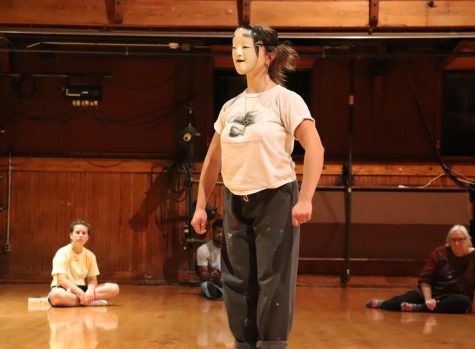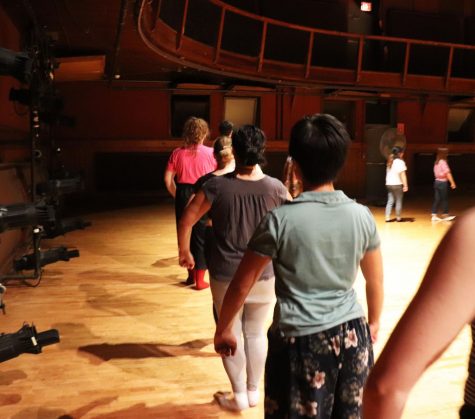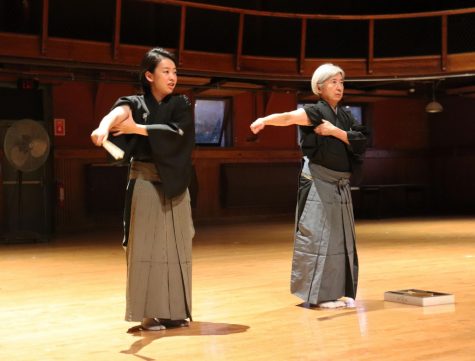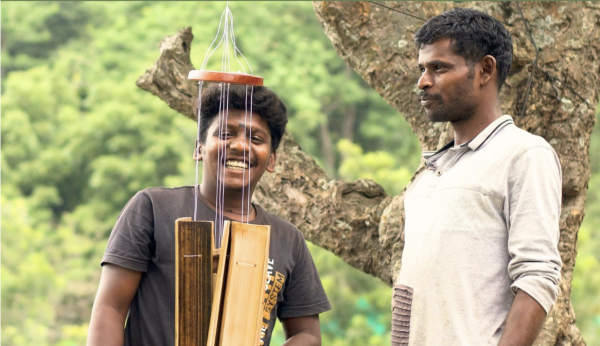Art and Gender: Behind Japanese Noh Theater

A student wears a traditional Noh mask.

Workshop attendees learn Noh theater movements.

Hikaru (left) and Hisa (right) Uzawa demonstrating Noh techniques.

Akane Little, OC ’19, and College fourth-year Georgie Johnson sit with Noh instructors.
Last weekend, Oberlin students and residents had the chance to experience Japanese Noh theater, presented by Hisa and Hikaru Uzawa, during the mother-daughter duo’s college campus tour. On Wednesday, they also led a Noh music workshop that taught chant notation, breathing, and posture.
Developed by Zeami Motokiyo, Noh theater has been around since the late 14th century. Noh stages, constructed with Japanese cypress, are tailored specifically to the needs of the play. A bridge called a hasigakari protrudes from stage right, where actors walk onstage through a curtain called an agemaku. There are three pine trees in front of the hasigakari which lead to the butai, the main stage, designed to give a sense of distance onstage. Every Noh stage has a kagamiita, a back panel painted with a pine tree.
In the performance narrative itself, there is often a “side” performer who appears in the first act of the play and meets the main character. The main character’s identity is revealed over time in the second act, as they don a Noh mask and an elaborate costume. The movement in the play is marked by strong posture and intense expressive capability, which is honed even before donning the mask.
Born into a family of Noh performers in Tokyo, actress Hisa Uzawa began studying the art of Noh at a young age, debuting in the play The Drunken Sprite as a toddler. Her daughter, Hikaru Uzawa, studied at the Kanze Tessenkai School of Noh Theater in Tokyo. Following in her mother’s footsteps, she debuted at three years old in The Aged Pine and performed her first lead role at thirteen. Together, the Uzawa duo has led workshops and collaborated in theater productions across Europe, North America, and Asia.
“Noh is a vibrant, living art form that practitioners and audiences have sustained for nearly seven hundred years,” noted Professor of Japanese Ann Sherif in an email to the Review. “The intermingling of dance, vocal and instrumental music, [and] richly literary libretti contributes to Noh’s expressive abilities. Although the classical Noh as we know it today emerged from elite warrior culture in Japan’s medieval period, Noh’s ability to express this world [and] other worlds, ethical and emotional challenges, and its aesthetic power are reasons that Noh remains a living performing art.”
Before their Wednesday rehearsal, the Uzawas sat down for a brief interview. Without the use of an interpreter, the conversation relied on a dialogue of smiles, enthusiastic nods, and a translator app.
“There are about 240 classic Noh plays, and every performance is a mask drama,” Hikaru Uzawa said. “There are a few roles where we don’t wear a mask because there are rules. Living male characters do not wear a mask. Even as characters who don’t wear masks, we never use facial expressions. The mask defines how we act.”
Between questions, Hikaru and Hisa spoke freely in Japanese to one another, answering together when asked about their time in a male-dominated craft.
“What is unique [about] Noh theater is that all [of it] is fixed,” Hikaru Uzawa said. “What is challenging for us is using our body. It is not a matter of gender — we don’t want to divide by that. But to capture the figure and deep voice is the most important [thing] in Noh theater. Most women have high voices, and so do some men. Those people have to train their voice — it depends on the person. We don’t think too much about gender, just the individual. One of our challenges is [figuring out] how to make our voice deeper and to have a larger figure on stage. We always talk to ourselves [about] our natural voice and how to make it deeper.”
More than just bodily constraints, Hikaru and Hisa fight societal challenges from those who believe that Noh theater is a male-dominated space.
“We use our whole life to practice making our voice deeper,” Hisa Uzawa said. “It is possible to solve the problem [of gender] on stage, but the social problem is harder, especially in Japan. We have a lot of customs, so fighting against that is difficult. We want to divide the theater and social world, but it is all connected.”
While Hikaru and Hisa are breaking boundaries in their craft, but they don’t want to be defined only by their accomplishments as women.
“We don’t want to be a ‘gender warrior,’” Hikaru Uzawa concluded. “We just want to perform. But we understand that there is a big problem.”
The Uzawas presented two plays during their stay. The first one, performed on Sunday, was The Feathered Cloak (Hagoromo), which tells the story of a fisherman returning a cloak to a celestial maiden who needs it to go back to heaven. The second play, Atsumori, is derived from The Tale of the Heike, a classic story about the 12th-century civil war fought between the rivaling Taira and Minamoto clans of Japan. With the help of Ann Sherif, professor of Japanese, Hikaru narrated the first act of the play, which segued into a performance of the climactic scene in the second half.
“Atsumori is a play about violence and war, and what unnatural death does to the human psyche — huge ethical and religious issues,” Sherif commented. “Hagoromo is about a fisherman who encounters a celestial being on his way home one day, which leads him to realize something about our human habits of suspicion and greed.”
The short residency of the Uzawas was an exceptional opportunity to experience the unique culture and tradition behind a long-surviving art form. They demonstrated their mastery of the craft as a physical art while battling











